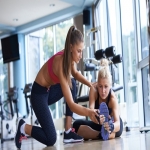As we continue our practice of social distancing and sheltering-in-place, we also see signs of spring and warmer temperatures approaching. This provides a prime opportunity for getting out and finding reprieve in the fresh air. While it is unclear how long it will be until life can return to “normal,” we can focus on improving our health through a process of prehabilitation. Afterall, exercise is medicine.

What is “prehabilitation?” This term refers to activities and health recommendations to improve health before a physical stress, such as a surgery, to help with tolerance for the event. In talking with patients about this concept, I often use the analogy of training for a marathon.
One could run a marathon without training, but the experience will obviously be more positive with preparation. The same is true with preparing our bodies and minds for health stressors.
In a recent article, Dr. Julie Silver applies prehabilitation to our current situation with the coronavirus. She reviews that a reduction in muscle mass and heart-lung function decline quickly when physical activity is reduced, and this can be especially concerning for the older population.
She discusses the challenge of maintaining health habits such as exercise while following shelter-in-place precautions and social distancing. However, with a bit of creativity we can practice consistent exercise and nutrition to maintain both physical and mental wellness. Exercise and stress reduction go hand-in-hand, and both of these are key for health.

It is intuitive that exercise makes us feel good, but author Dr. Kelly McGonigal explores why in her book, The Joy of Movement. Through a deep dive into research on this topic, she describes how exercise reduces inflammation and anxiety while it increases energy and social bonding (yes, even while at a distance). Exercise truly is medicine!
One of my favorite passages in her book explores the connection between outdoor physical activity (“green exercise”) and mood. Even short periods of movement outside have the power to lift our spirits and quiet our minds.
Laurel Short, DNP, FNP-C
Nurse Practitioner for Dr. Atul Patel

Multiple studies show that outdoor exercise reduces depression, which is not surprising given that our species evolved spending much more time outside than in the modern era. On the next warm day, find a green space near your home or in a park to take a walk, lay out a yoga mat, or simply sit on a blanket and drink in the spring air.
Here are some helpful resources to create your own prehabilitation routine. Remember to set small, realistic goals as you strive to optimize your fitness during this pandemic. Please contact your medical provider if you need assistance in determining what activities are best for you.
Free Online Yoga
Free Strength Videos
Pelton Group Exercise
Free Recipes and Nutrition
These apps are designed for relaxation techniques, and are basic free formats with optional subscriptions.
Headspace
Learn the life-changing skills of meditation in just a few minutes a day with Headspace.
Stop, Breathe, & Think
Slow down, take a deep breath…how are you feeling, what are you thinking?
Calm
Guided meditation sessions are available in lengths of 3, 5, 10, 15, 20 or 25 minutes so you can choose the perfect length to fit with your schedule.
Written by: Laurel Short, DNP, FNP-C
Laurel Short DNP, MSN, FNP-C, has been working with Dr. Atul Patel for nearly nine years, treating a variety of medical conditions including musculoskeletal pain, neurologic rehabilitation, and spasticity.
References:
McGonigal, K. (2019). The Joy of Movement. Penguin, Canada.
Silver, J.K. (2020). Prehabilitation could save lives in a pandemic. Accessed from blogs.bmj.com

